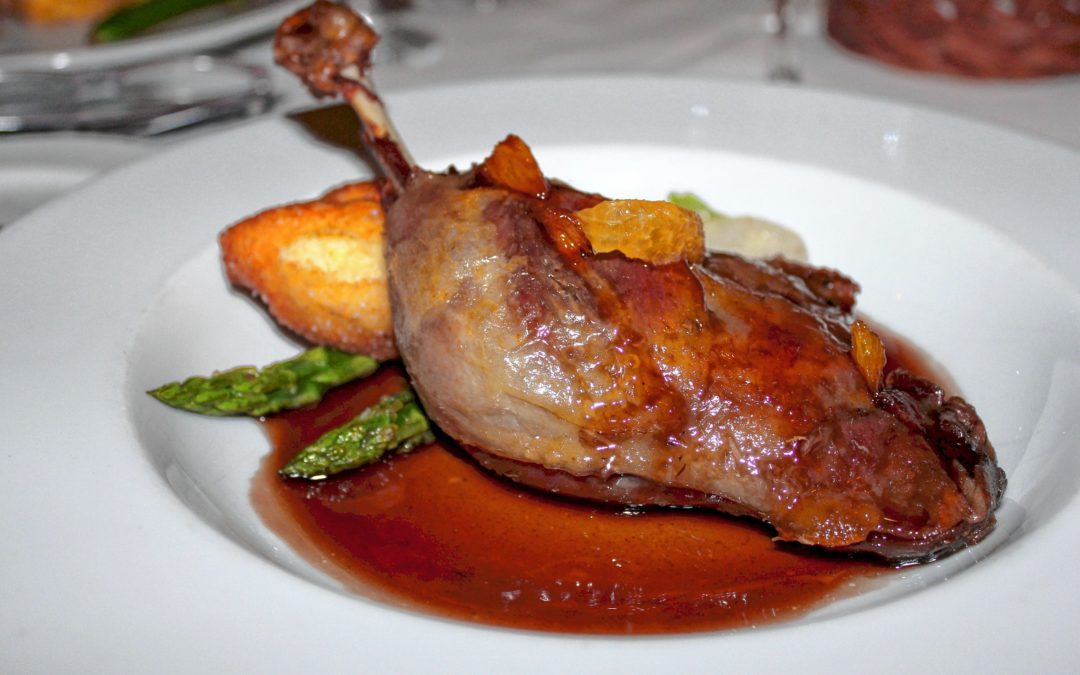Traditional Confit de Canard
If you find yourself in possession of some duck legs, it’s not too difficult to reproduce that classic French dish: Confit de Canard (duck confit) at home. Despite the large amounts of rendered fat used in the preparation and storage, there is nothing greasy about it. Rather, the texture is nutty, silky, delicate, and almost fat-free. Serve your confit with french fries, green beans and a tossed green salad as the French often do. Pour a glass of wine and enjoy!
INGREDIENTS
5 pounds duck legs (Pekin, Moulard or Muscovy)
3 T plus 1 tsp coarse Diamond Crystal kosher salt or 2 tsp per pound of meat
1 ½ T coarsely chopped shallots
1 tsp coarsely chopped fresh garlic plus 1 whole head of garlic, halved crosswise
1 ½ T chopped fresh Italian parsley
2 tsp black peppercorns, lightly crushed
1 bay leaf, crumbled
1 sprig of fresh thyme, chopped or a large pinch of dried thyme
6 cups rendered duck or goose fat
2 whole cloves
DIRECTIONS
1. Cure the duck: Rinse duck pieces and dry thoroughly. In a large bowl, toss the duck with the salt, shallots, chopped garlic, parsley, peppercorns, bay leaf, and thyme. Cover with plastic wrap and refrigerate for 18 to 24 hours.
2. Rinse the marinated duck pieces under cold running water to rinse off the salt and seasonings. Drain briefly. Place the rendered duck fat in a large, very heavy pot and melt over low heat.
3. Stick a whole clove into each half-head of garlic and add to the melted fat. Slip in the pieces of duck. Cook, uncovered in the pot until the fat reaches 190 degrees. This should take about 1 hour; faster heating will result in stringy texture. Add additional rendered fat, if necessary to cover the duck. Continue cooking at 192 degrees to 210 degrees, but no higher, adjusting the heat level as necessary, for another 1 hour or up to 2 hours until a toothpick pierces the thickest part of a thigh easily. Remove from the heat and let the duck cool in the fat for 1 hour.
4. Meanwhile, set out three 1-quart crocks, tupperware-style containers or large glass jars. Pour boiling water into each container; swirl and pour out. Thoroughly dry the inside of the containers.
5. Transfer the duck legs to the containers filling each about ¾ full without overcrowding.
6. Carefully pour the rendered fat over the duck legs and leave a generous inch of air space between the surface of the fat and the rim of the container.
7. Place containers in the refrigerator and use within one week, or freeze for up to 6 months.
8. Reheat your duck legs: Bring the container to room temperature and carefully remove the legs from the fat. Heat up a frying pan and place the duck legs in the hot pan and heat thoroughly until the skin crisps up.
PAIRINGS
Wines to pair with duck that are available at N.H. Wine and Liquor Outlet:
Malbec: Chateau de Cénac Cuvée Prestige, Cahors, France
Pinot Noir: Hangtime Pinot Noir, California
Pinot Noir: A Bichot Fixin Pinot Noir, Burgundy, France
Zinfandel: Omen Zinfandel, California
Pinot Gris: Hugel Alsace Pinot Gris Classic, Alsace, France


 View Print Edition
View Print Edition